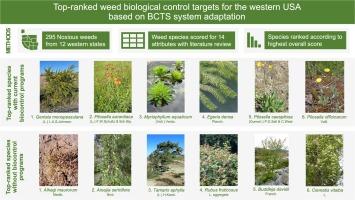Prioritizing weeds for biological control development in the western USA: Results from the adaptation of the biological control target selection system
IF 3.7
2区 农林科学
Q2 BIOTECHNOLOGY & APPLIED MICROBIOLOGY
引用次数: 0
Abstract
Nonnative invasive plants (weeds) negatively impact native ecosystems, and their effects are likely to increase with continuing global trade. Biological weed control has been employed as a cost-effective and sustainable management option for weeds in the USA since 1902. Biological control programs require careful prioritization of target weeds to ensure the most appropriate targets are selected to obtain the greatest beneficial outcomes with available resources. The Biological Control Target Selection (BCTS) system was developed by researchers in South Africa as an objective, transparent approach to prioritizing new weed biological control targets. The BCTS system was recently modified and applied to 295 state-regulated weeds in the western USA for which no biological control agents have yet been released. This paper presents the results of that application, identifying the most suitable candidates for new biological control programs as well as problematic weeds for which the likelihood of successful biological control is low.
Top-ranked species in the western USA are biennial or perennial weeds that occur in stable habitats, are established in more than one state, have traits deemed difficult to control with conventional methods, have large negative impacts and no conflicts of interest outside of the horticultural industry, and have substantial information available on potential biocontrol agents. Fifteen of the 20 top-ranked species are already targets of ongoing biological control programs in the USA. When species with current programs are excluded from the analysis, the next 20 top-ranked species largely differ by having less information available on potential biological control agents and having native or economically important congeners in the USA. Results from this framework provide valuable insights to the prioritization of current and future biocontrol research programs in the western USA.

美国西部优先发展生物防治杂草:生物防治目标选择系统的调整结果
外来入侵植物(杂草)对本地生态系统造成了负面影响,而且随着全球贸易的不断发展,其影响可能会越来越大。自 1902 年以来,美国一直将生物除草作为一种具有成本效益且可持续的杂草管理方法。生物防治计划需要对目标杂草进行仔细的优先排序,以确保选择最合适的目标,从而利用现有资源获得最大的有益效果。生物防治目标选择(BCTS)系统由南非研究人员开发,是一种客观、透明的方法,用于确定新杂草生物防治目标的优先次序。BCTS 系统最近经过修改,应用于美国西部 295 种尚未释放生物防治制剂的国家管制杂草。美国西部排名靠前的物种为二年生或多年生杂草,这些杂草生长在稳定的栖息地,在一个以上的州都有分布,其性状被认为难以用传统方法控制,有较大的负面影响,在园艺行业之外没有利益冲突,并且有大量关于潜在生物控制剂的信息。在这 20 个排名靠前的物种中,有 15 个已经成为美国正在进行的生物防治计划的目标。如果将正在实施生物防治计划的物种排除在分析之外,排名前 20 位的物种在很大程度上有所不同,它们在潜在生物防治媒介方面的信息较少,而且在美国有本地或经济上重要的同系物。该框架的结果为确定美国西部当前和未来生物防治研究计划的优先次序提供了有价值的见解。
本文章由计算机程序翻译,如有差异,请以英文原文为准。
求助全文
约1分钟内获得全文
求助全文
来源期刊

Biological Control
生物-昆虫学
CiteScore
7.40
自引率
7.10%
发文量
220
审稿时长
63 days
期刊介绍:
Biological control is an environmentally sound and effective means of reducing or mitigating pests and pest effects through the use of natural enemies. The aim of Biological Control is to promote this science and technology through publication of original research articles and reviews of research and theory. The journal devotes a section to reports on biotechnologies dealing with the elucidation and use of genes or gene products for the enhancement of biological control agents.
The journal encompasses biological control of viral, microbial, nematode, insect, mite, weed, and vertebrate pests in agriculture, aquatic, forest, natural resource, stored product, and urban environments. Biological control of arthropod pests of human and domestic animals is also included. Ecological, molecular, and biotechnological approaches to the understanding of biological control are welcome.
 求助内容:
求助内容: 应助结果提醒方式:
应助结果提醒方式:


